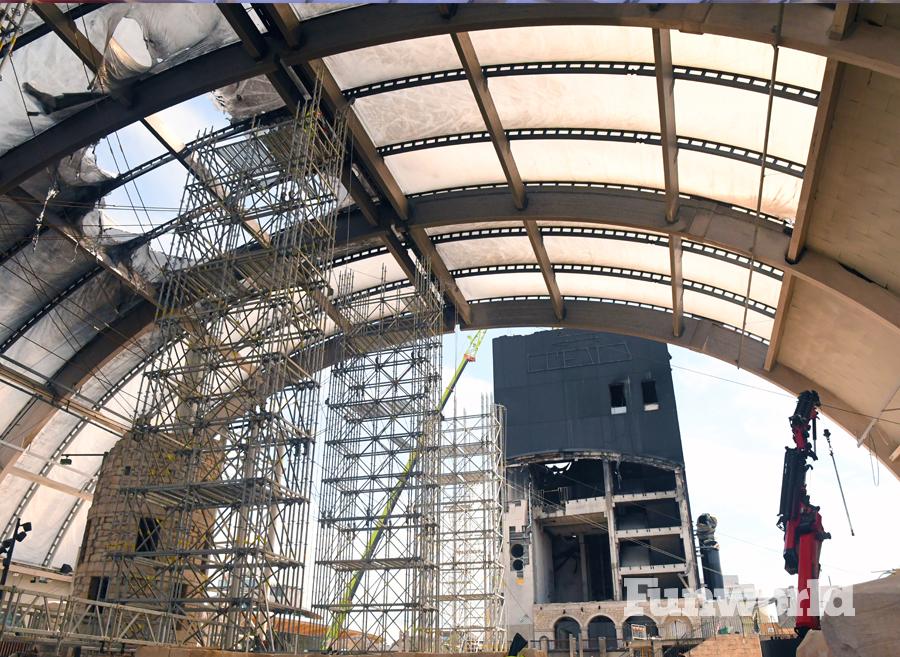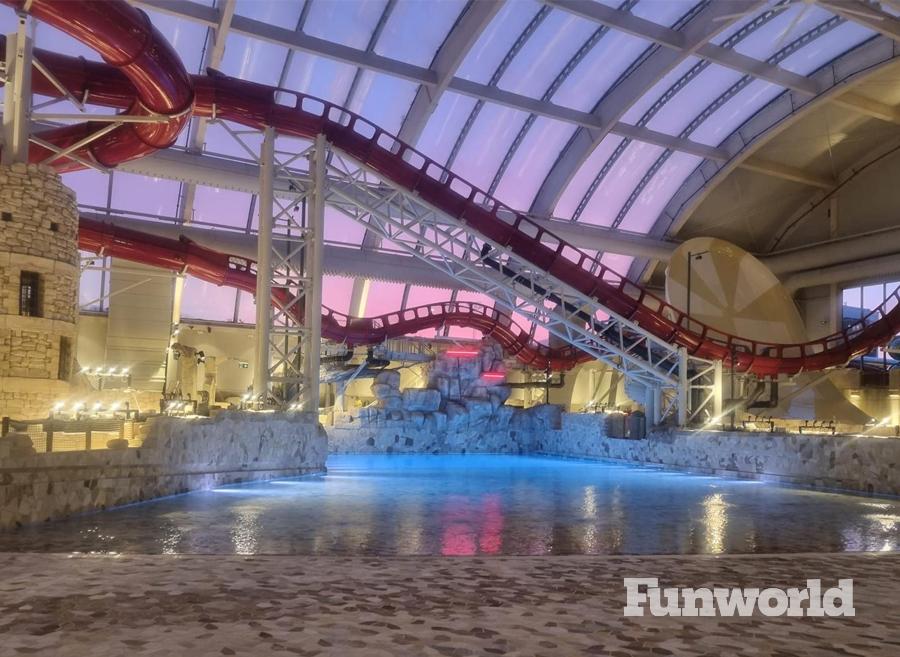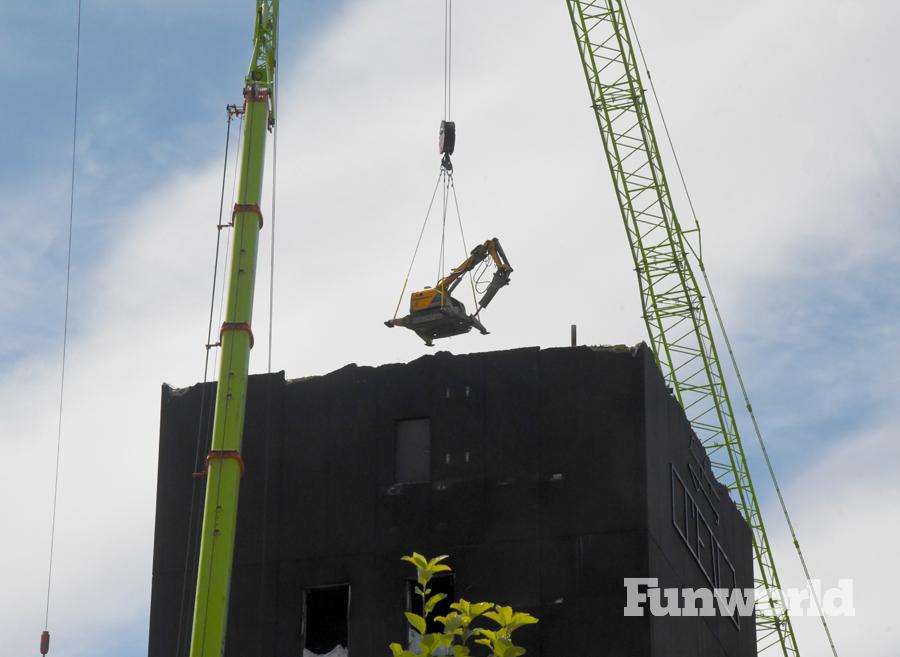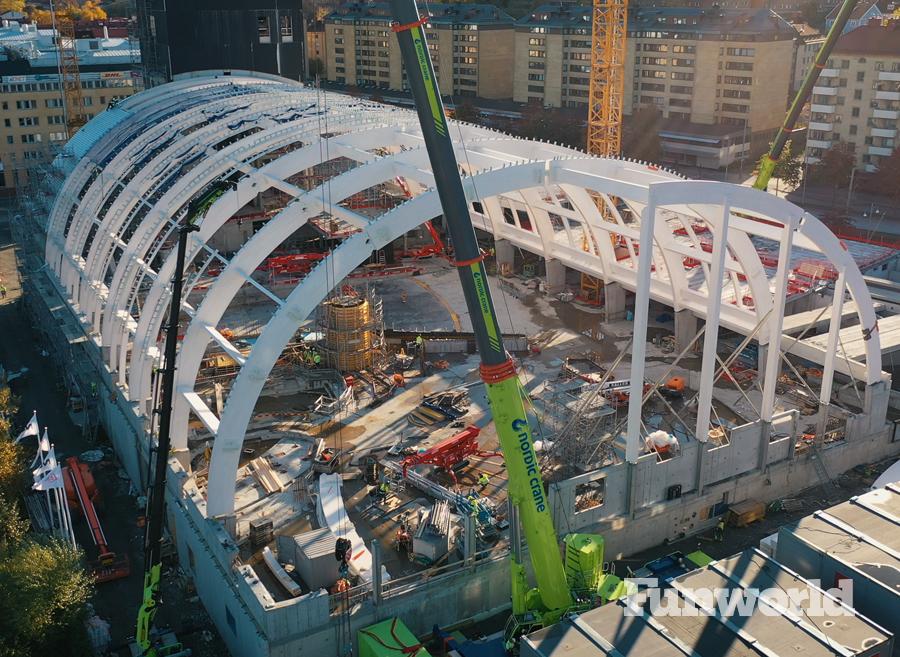On the morning of Feb. 12, Thomas Sjostrand found himself enjoying a snow skiing holiday in the north of Sweden. The vacation served as a final respite for Sjostrand, Liseberg’s chief project officer (CPO), before beginning the final push to complete
Oceana, Liseberg’s new indoor water park resort.
“I felt my phone while I was waiting to get up on the ski lift,” Sjostrand remembers of the vibration through his ski jacket at 10:10 a.m. “My pocket was shaking.”
Upon pulling out his mobile phone, Sjostrand froze.
Images on his smartphone displayed thick, black smoke emanating from Oceana following a massive explosion. Calls then began arriving in quick succession.
While Sjostrand received messages on the slopes, Liseberg CEO Andreas Andersen began receiving phone calls as he dropped his dog off at day care. From his vantage point, Andersen observed a stream of heavy smoke wafting over Göteborg.
“You could see the damage was substantial,” he recalls upon arriving at the park. Meanwhile, Sjostrand got out of line at the chairlift and returned to the cabin his family had rented. Both men jumped on a crisis call at 10:30 a.m. Sjostrand remained on the call until 3 p.m., before driving back to Göteborg, home to the century-old Swedish theme park.
In the hours and days that followed, Liseberg leadership was forced to face the uncertainty of how to move forward on a multimillion-krona project—and found themselves relying upon each other for direction and support.
“Trust between colleagues is a key thing. I think this glued us all together,” Sjostrand says.
The devastating fire took place 110 days before Oceana’s scheduled June 1 grand opening.
“We were so close,” Andersen says reflectively, pausing to look out a window facing Oceana during a conversation with Funworld days after the proposed grand opening in June.
Liseberg provided IAAPA News exclusive access to the beloved property and her devoted caretakers in June 2024. Key stakeholders shared with Funworld their learnings and advice for other attractions leaders when uncertainty strikes.
In the Beginning
The year was 2013. Liseberg had just purchased a shuttered automotive factory just beyond its gates that manufactured gears for Saab and Opal.
“We started to think what we should do with the land,” Sjostrand recalls. While a hotel and indoor water park topped the list, Liseberg’s board of directors challenged park planners to present additional ideas. They went on to create 33 different options.
“It was everything—blue skying: retail, aquarium, brand experience, expanding the amusement park, etc. etc.,” Sjostrand tells Funworld. From there, planners narrowed down their options to eight concepts that best honored the purpose of Liseberg: to help attract people to the city of Göteborg and make memories, according to Sjostrand. With a hotel and indoor water park facility, Liseberg could now attract visitors year-round—and drive revenue—especially during the chilly winter and early spring, when the theme park is closed for the season.
Andersen says the decision was data driven, while the naming criteria for Oceana had to be poetic, self-explanatory, and mean the same in Swedish and English.
“It’s about journeys, going out in the world, and coming back with ideas and inspiration,” Andersen says.
Liseberg sought insight from its longtime theme park designer David Schofield, along with partners such as WTI, Wingårdhs (who also designed the neighboring Grand Curiosa Hotel), Swedish contractor NCC, and slide provider WhiteWater.
Construction at the urban site trudged on at varying paces throughout the COVID-19 pandemic, supply chain delays, and quality upgrades. (After the prefabricated patterns of a Brazilian stone tile arrived with unanticipated gaps, artisans separated each stone from its netting and laid each rock by hand. “We wanted to create something that had a good sense of quality; we wanted to work with natural materials,” says Andersen.)
By Jan. 15, 2024, crews had filled the wave pool with water for the first time.
“It was a very special moment. All the primary stakeholders from the project were there. The press was invited,” recalls Pontus Hallsberg, Liseberg’s commercial coordinator. Perhaps one of Liseberg’s most visible employees, Hallsberg serves as Liseberg’s trusted ambassador, providing tours for VIP guests, politicians, and business leaders. “We took turns holding the hose; we laughed, and we were excited that a big step was reached.”
Hallsberg visited Oceana for the last time three days before the fire.
“The pools were filled; the water was rippling in the waterfalls; the paint on the large murals in the hallway had dried; the handmade rock formations were finished; the last mosaic of the Brazilian natural stone was laid; and the slides were clean of all construction dust,” he says. “Even though it was not complete in terms of appearance … you could really see what kind of soul Oceana would have.”
Sticking to the Plan
After dropping off his dog on the morning of the fire, Andersen joined other members of Oceana’s crisis team in a third-floor conference room. The team was predetermined—even before the construction crew’s first shovel hit the dirt in 2020. The plan spelled out who would have a seat at the table should disaster strike. The team quickly determined it was necessary to evacuate guests and employees from the posh Liseberg Grand Curiosa Hotel and adjacent office buildings. Hallsberg reflects on how the breeze on Feb. 12 blew the smoke away from the hotel and theme park—potentially limiting the fire’s scope.
During the first few days, no members of the crisis team toured the site (after all, they were not trained first responders).
“You want the crisis management team to be a little away from where it happens,” recommends Andersen. “If you have to make decisions, you don’t want to be in the middle of everything.”
Sjostrand focused on the communication with the fire brigade, police, and main contractor.
“I had all the information,” recalls Sjostrand, who then had the duty to share updates with the crisis team, but not the press. The responsibility of spokesman fell to Andersen.
“We knew from the beginning somebody was missing,” Sjostrand tells Funworld. Unaccounted for was Patrik Gillholm, a well-regarded former employee who returned to Liseberg to work on Oceana as a contractor.
Investigators knew where Gillholm’s mobile phone had last pinged before losing its signal on Feb. 12. Yet, with Oceana’s multi-story slide tower still smoldering, it was not safe to enter the structure until five days after the explosion that consumed a majority of Oceana’s water slides.
“I had to tell them, ‘The police are not searching anywhere else,’” Sjostrand says when reviving somber memories of informing the crisis team of Gillholm’s passing.
[Editor’s Note: Funworld will not speculate on the cause of the fire. The Swedish Accident Investigation Authority is conducting its investigation and is projected to issue its full report in spring 2025.]
Staying Strong, Being Bold
“Our project had literally gone up in smoke—burnt to ashes—and we had lost our colleague Patrik,” Hallsberg reflects. “The coming weeks was a period of tears, sorrow, frustration, anger, hopelessness, and emptiness.”
When faced with adversity, Sjostrand recommends other professionals try to follow a balanced schedule.
“I went home every night,” Liseberg’s CPO says, electing to drive home instead of sleeping in his office. “Emotionally, it’s quite tough,” he says. “You wake up in the middle of the night. It’s quite terrible.” Thus, Sjostrand gave himself permission to visit the gym, go for a jog on Saturday mornings, have dinner with his family, and take each day step-by-step.
“You need to see the small glimpses of light,” he recommends. “You need to meet your friends, your colleagues,” adding that genuine discussion can be therapeutic.
The park provided grief counselors, with Sjostrand explaining many employees booked appointments for each other, feeling that some of their fellow colleagues could use the one-on-one assistance. And within the office, shedding a tear was permissible.
“I did that with them: On my team, we cried together,” Sjostrand says. He also believes sharing details internally is just as important as sharing information with the media.
“If you send out a press release, you should inform your team first,” he says.
When facing a crisis, Andersen compares leadership to building equity in a bank account.
“That capital is trust, respect, transparency. When something like this happens, you have to withdraw from that account,” Andersen says. He recalls admiring the professionalism of his team in the early days of the disaster. “They were just so good. They were like an orchestra—all the instruments they played together—without me needing to conduct every little detail. I think this is attributed to many years of coexistence with the same team.”
Pivot Planning
While a team of architects, designers, and contractors invested years in the planning of Oceana, they took only months to create a plan that in effect will “secure, fix, and take things down,” according to Sjostrand. Deconstruction began this summer to remove Oceana’s charred slide tower. In the coming months, crews will remove a dozen scorched wooden arches over the wave pool. Each beam weighs 22 tons. Sjostrand says teams will use the winter months to safely “take one down, and then add a new one” in a succinct fashion to maintain structural integrity. Elsewhere on the site, Sjostrand’s team is working with Liseberg’s insurance companies to determine if everything is still operational—from the air conditioner to the watertight capabilities of the hand-laid tile floor. Navigating the insurance process is expected to take more than a year. (Meantime, more than 100 trees—some nine meters tall—and bushes earmarked for the project are still in waiting at greenhouses located in the Netherlands.) Sjostrand says “good conversations” continue with WhiteWater to again fabricate water slides for the facility.
“We were proud of Oceana,” says Hallsberg. “For me, it was a symbol of our faith in the future.”
Moving Forward
On July 17, Liseberg’s board of directors made the formal decision to rebuild Oceana following several months of extensive research. Park leaders invested time completing cost analyses, commissioning sustainability studies, and attending countless meetings following the blaze. After pouring over the data, their investigation determined rebuilding Oceana would prove more economical than demolishing the structure and later commencing an alternative project on the same site.
“Based on the various scenarios we have developed, there is really no alternative to completing the project. This applies both to Liseberg and Göteborg as a tourism destination,” says Andersen.
A complete overhaul would entail write-downs of large values and not be justifiable from a sustainability perspective.
The entrance lobby, ticketing area, kitchen, and locker rooms escaped unharmed. Even the new turnstiles remain in place and safely shrouded in their protective packaging. Necessary water filtration equipment located in the basement of the facility appears to be in working condition. During Funworld’s visit in June, a high-water mark was evident on a cellar wall, a reminder of the water sprayed on the structure by firefighters on Feb. 12. At less than a foot tall, the standing water did not harm the equipment already installed. Wisely, Liseberg set the equipment on permanent, elevated risers, thus protecting equipment from a flood.
The slide tower will be rebuilt with a new aesthetic that will differ in appearance from the original tower that burned. For Hallsberg, a change on the horizon is welcome.
“I hope that sometime in the future I get to experience that feeling and pride again,” he shares.
Financing the Return
Until the cause of the fire is definitively determined and clarity is found on compensation, the project will be bridge-financed by Liseberg. This will initially be handled through re-prioritization of Liseberg’s investments and cashflow. Further bridge-financing from the city of Göteborg—Liseberg’s owner—may become necessary during reconstruction.
“We have good hopes of covering the costs of rebuilding Oceana, but the process is complex and long—perhaps several years,” Andersen says. “A lengthy process can jeopardize the future of the project and, in all likelihood, increase the cost significantly. It will be a tough journey, where we will have to prioritize our resources, our investments. And it may also have consequences for our organizational set-up.”
Reconstruction will begin this autumn with a new completion date targeted for 2026.
Despite the challenges ahead, Liseberg is bullish on the future. Already, a plan filed and approved by the city of Göteborg allows for the park to greater develop its southeast corner next its new neighbor, the World of Volvo, an experience center and museum celebrating the Swedish automotive manufacturer. That includes room for several additional hotels, an indoor or outdoor expansion of Oceana, and an expansion of the traditional amusement park.
“We’ll be here for another 100 years,” Sjostrand concludes with confidence.
Scott Fais is the director of global editorial at IAAPA. The six-time Emmy Award-winning journalist enjoys visiting creative attractions of all kinds—and meeting the professionals behind them. Connect with him on LinkedIn.
- This original reporting from IAAPA News first appeared in Funworld magazine. For more stories and videos covering the global attractions industry and to read a digital version of Funworld magazine, click here.




